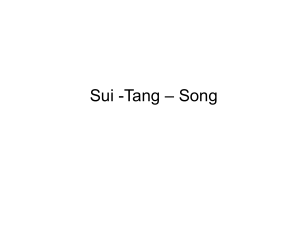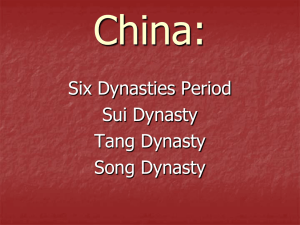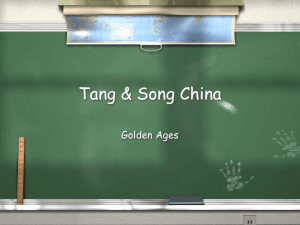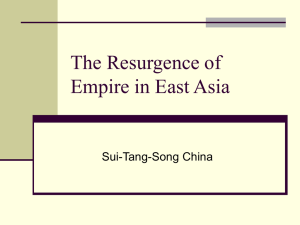Chapter 12: Reunification and Renaissance in Chinese Civilization
advertisement
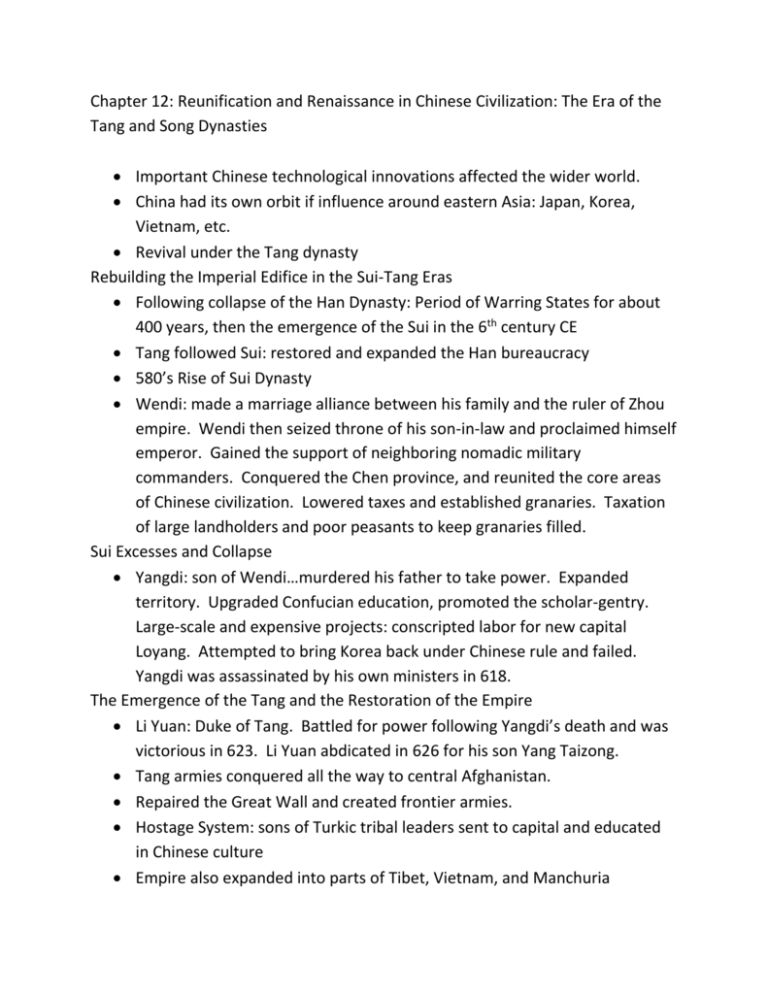
Chapter 12: Reunification and Renaissance in Chinese Civilization: The Era of the Tang and Song Dynasties Important Chinese technological innovations affected the wider world. China had its own orbit if influence around eastern Asia: Japan, Korea, Vietnam, etc. Revival under the Tang dynasty Rebuilding the Imperial Edifice in the Sui-Tang Eras Following collapse of the Han Dynasty: Period of Warring States for about 400 years, then the emergence of the Sui in the 6th century CE Tang followed Sui: restored and expanded the Han bureaucracy 580’s Rise of Sui Dynasty Wendi: made a marriage alliance between his family and the ruler of Zhou empire. Wendi then seized throne of his son-in-law and proclaimed himself emperor. Gained the support of neighboring nomadic military commanders. Conquered the Chen province, and reunited the core areas of Chinese civilization. Lowered taxes and established granaries. Taxation of large landholders and poor peasants to keep granaries filled. Sui Excesses and Collapse Yangdi: son of Wendi…murdered his father to take power. Expanded territory. Upgraded Confucian education, promoted the scholar-gentry. Large-scale and expensive projects: conscripted labor for new capital Loyang. Attempted to bring Korea back under Chinese rule and failed. Yangdi was assassinated by his own ministers in 618. The Emergence of the Tang and the Restoration of the Empire Li Yuan: Duke of Tang. Battled for power following Yangdi’s death and was victorious in 623. Li Yuan abdicated in 626 for his son Yang Taizong. Tang armies conquered all the way to central Afghanistan. Repaired the Great Wall and created frontier armies. Hostage System: sons of Turkic tribal leaders sent to capital and educated in Chinese culture Empire also expanded into parts of Tibet, Vietnam, and Manchuria Korea was overrun in 668 and a vassal kingdom, Silla, was established. Rebuilding the Bureaucracy Revived scholar-gentry elite Scholar-gentry continued to gain more power under the Tang and were used as rivals to aristocratic control. Subprefecture: district level of the bureaucracy Bureau of Censors to keep an eye on officials and report them if necessary New Tang Capital: Changan The Growing Importance of the Examination System Academies were established to train officials in Confucian classics Number of educated scholar-gentry increased greatly. Ministry of Rites: in charge of administering differed kinds of exams to students from government schools or to those recommended by distinguished scholars. Part of the Civil Service Jinshi: exceptional scholars that passed tests based on philosophical or legal classics and Chinese literature. Gained special social status and recognition. Birth and family connections was still important for a person to get onto the scholar-gentry track. Technically the bureaucracy was open to commoners, but was still dominated by a small number of established families. State and Religion in the Tang-Song Era State patronage for Confucianism undermined aristocratic families and Buddhist monastic orders. Buddhism thrived and spread in China following the decline of the Han Empire Pure Land Sect: Salvationist, branch of Mahayana Buddhism, appealed to lower classes, spoke of devotion and the return of a Savior. Chan Buddhism/ Zen Buddhism: popular among the elites. Emphasized meditation, and the appreciation of natural and artistic beauty. Goal: to know the ultimate wisdom and find nirvana (release from the cycle of rebirth), through introspective meditation. “Being empty means having no appearance,” Buddhism had become a strong social, economic, and political force by the time of the Tang unification. Empress Wu (690-705CE): Tang ruler who supported Buddhism. Commissioned Buddhist paintings and sculptures and attempted to elevate Buddhism to a state religion. Also had huge pagodas built. By mid-9th century: nearly 50,000 monasteries and hundreds of thousands of Buddhist monks and nuns in China The Anti-Buddhist Backlash Confucian and Daoist criticism of Buddhism as an alien religion Confucian scholars tried to convince Tang rulers that Buddhist monasteries were a financial drain because their lands were not taxed. Emperor Wuzong (r. 841-847CE): began open persecution of Buddhism. Thousands of monasteries and Buddhist shrines were destroyed…had to return to civilian life and pay taxes. Buddhism survived, but was politically weakened. Confucianism emerged as the central ideology of Chinese civilization for most of the period from the 9th to the early 20th centuries. Tang Decline and the Rise of the Song * Tang: internal rebellions and nomadic incursions * Early 10th century: Song Dynasty * Song: Confucian revival * Nomadic invasions: mid-12th century: Song lost control of northern China, then 150 years later southern China fell to the Mongols. * Empress Wei: poisoned her husband, placed her small child on throne, another prince thwarted her plans. * Xuanzong (r. 713-756): peak of Tang power and the high point of Chinese civilization under the dynasty. Began by strengthening the govt. and economy, but then patronized the arts more and became distracted by concubines, especially Yang Guifei. Yang Guifei gained high ranking positions for her family members. 755 revolt led by An Lushan, Xuanzong's troops mutinied and he was forced to have Yang Guifei executed. * Late 8th and 9th centuries nomads used political divisions within China to gain entry into and eventually assert control over large areas of the north China plain. * Succession of revolts in 9th century against the Tang, some were led by peasants The Founding of the Song Dynasty * 907: last emperor of Tang Dynasty forced to resign * Zhao Kuangyin (Emperor Taizu): united the empire in 960. Scholar, collected books. Founder of the Song Dynasty * 907: Liao Dynasty was founded by the Khitan peoples from Manchuria in northern China. Very militaristic and by 1004: Song had to sign a series of treaties with Khitan. Song had to pay tribute. Song Politics: Settling for Partial Restoration * Song was not as powerful as the Tang Dynasty * Military was subordinated to the civilian administrators of the scholar-gentry class. * Military commanders were rotated to prevent them from building up a power base in the areas where they were stationed. * Song had a lot more scholar-gentry emerge during the period The Revival of Confucian Thought * Revival of Confucianism * Zhu Xi: prominent thinker, emphasized applying philosophical principles to everyday life and action. **Neo-Confucians: Revivers of ancient Confucian teachings, believed that cultivating personal morality was the highest goal for humans. Virtue could be attained by knowledge, with book learning and observation, and contact with men of wisdom and high morality. Believed good nature of humans could be cultivated. Emphasized tradition and hostility to outside influences. Rank, obligation, deference, and traditional rituals Roots of Decline: Attempts at Reform * Xi Xia: kingdom established b the Tangut tribes in Tibet. Song Dynasty had to pay tribute to them for protection of their northern borders * Song was maintaining an army of nearly 1 million soldiers by mid-11th century. * Wang Anshi: 1070's and 1080's chief minister of the Song Shenzong emperor, tried to introduce sweeping reforms. Subscribed to some Legalist beliefs. Introduced agricultural stimulus programs, taxed land-lord and scholar-gentry class, used new mercenary forces, instead of conscripted peasants, tried to change education as well. Reaction and Disaster: The Flight to the South * 1115 nomadic Jurchens: overthrew the Liao dynasty of the Khitans and established the Jin kingdom north of the Song Empire. Song had to flee to the south. * Southern Song Dynasty (1127-1279) Tang and Song Prosperity: The Basis of a Golden Age * Shifts in population within China * New patterns of trade and commerce, new technological breakthroughs * Grand Canal: designed to link the north and south. * Population increased in the south * South: rice-growing areas: major food-producing areas of the empire * Yangdi's Grand Canal became a vital link between the north and south: was 1200 miles long A New Phase of Commercial Expansion * overland silk routes between China and Persia were reopened and protected. * China exported mainly manufactured goods to overseas areas, such as southeast Asia and imported luxury products such as aromatic woods and spices. * Chinese junks were the best ships in the world during this time period. * Market quarters in cities and towns, merchants banded together into guilds * Flying money: credit vouchers that were presented for reimbursement at the appropriate office in the city of destination. (similar to traveler's checks). The World's Most Splendid Cities * Changan: population of nearly 2 million * Hangzhou: late Song capital: located near Yangtze River and coast of East China Sea, had nearly 1 1/2 million residents * Known for many opportunities for entertainment Expanding Agrarian Production and Life in the Country * movement of population southward to the fertile valleys of the Yangtze river valley * support of military * State regulated irrigation and embankment systems * Introduction of wheelbarrow and new crops: Champa rice "quick rice" from Vietnam * Redistribution of aristocratic lands * Architecture amongst the upper class: curved roofs Family and Society in the Tang-Song Era * Extended family households preferred, usually only feasible for the elite. * Punishments for breaking relationships: example beheading of children if they hit their parents or grandparents * Important role of the Matchmaker * Some elite women gained power * Divorce by mutual consent was allowed by mutual consent of both husband and wife. * Some elite women took lovers "complementary husbands" The Neo-Confucian Assertion of Male Dominance * Worsening condition of women in general * Neo-Confucian promoted male dominance: women's role as homemaker and mother, especially of sons. * Advocated confining women, virginity for young brides, fidelity for wives, and chastity for widows. * Men could have concubines * Footbinding**: preference of small feet for women...young girls feet were bound around 5 or 6. Toes were turned under and bound with silk, "lotus petal" "golden lily" shapes. Constant source of pain and limited a woman's mobility as well as occupations. Lower classes were slower to adopt the practice. Eventually became vital to winning a husband. A Glorious Age: Invention and Artistic Creativity * Poetry and short stories of Tang * Landscape paintings of Song * Banks and paper money helped the economy * Complex irrigation systems: dykes, dams, Grand Canal * New types of bridges * Tang era: invention of explosive powder: (gunpowder) * Chairs introduced to the household (think of Ban Zhou picture) * Song Dynasty: Compasses, abacus, printing with movable type (by Bi Sheng) Scholarly Refinement and Artistic Accomplishment * Tang Period: focus on Buddhist art and architecture * Scholar-gentry was encouraged to be well-rounded: art and writing * Li Bo: most famous poet of the Tang era...images of everyday world with philosophical musings. * Intense interest in nature:Song landscape paintings * Emphasis on subtlety and suggestion.



